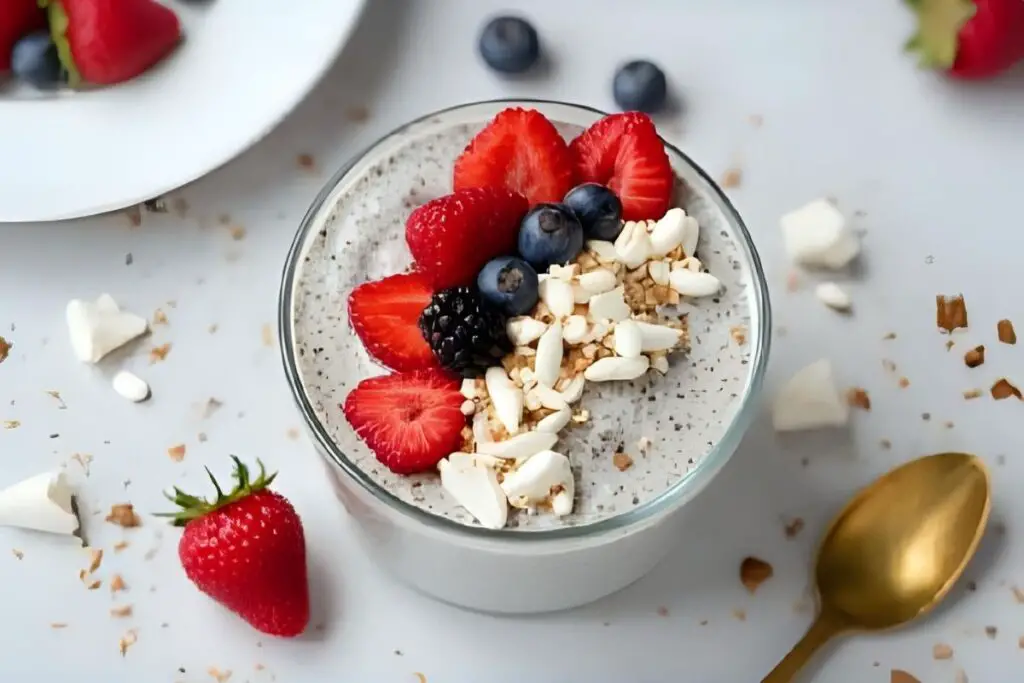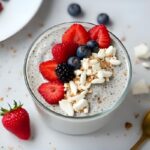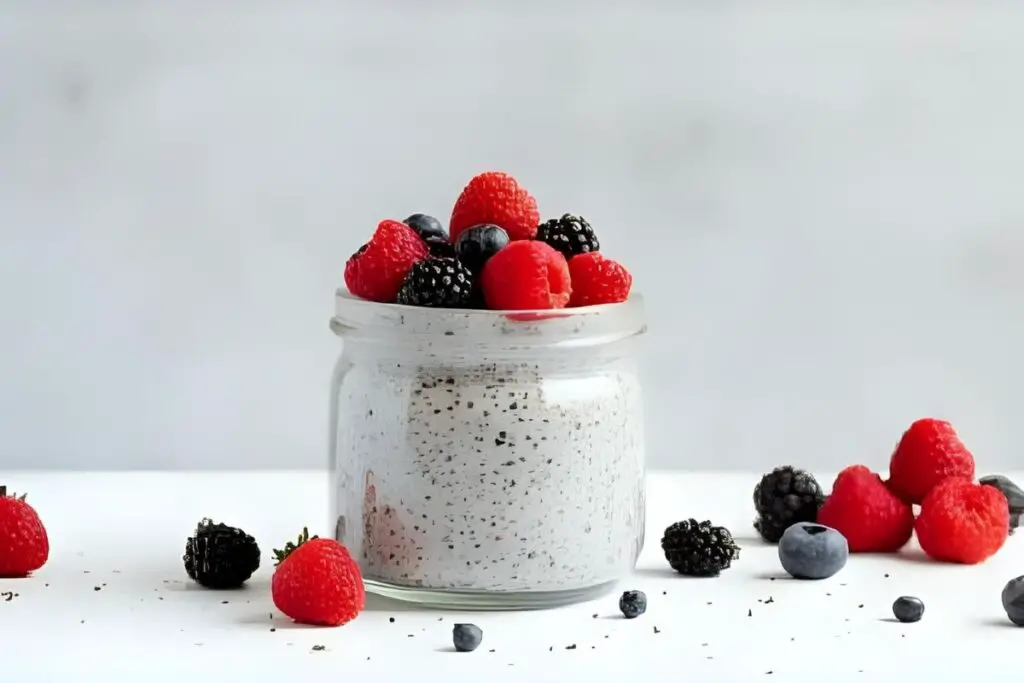Table of content
Table of Contents
Introduction

If you’re searching for a delicious, healthy dessert or snack that fits perfectly into your low-carb lifestyle, the keto chia seed pudding recipe is your new best friend. This creamy, nutrient-packed pudding is not only incredibly simple to whip up but also offers a delightful texture and flavor that can satisfy your sweet cravings without the sugar spikes. Whether you’re just starting the keto diet or looking for a guilt-free treat, this recipe promises low-carb bliss in just three easy steps.
Chia seeds have taken the health world by storm due to their impressive nutritional profile, featuring omega-3 fatty acids, fiber, and antioxidants. When soaked, they swell into a gel-like consistency, making them an ideal base for puddings that feel indulgent but are surprisingly light and nourishing. By pairing chia seeds with low-carb milk alternatives and keto-friendly sweeteners, you get a creamy dessert that fits a ketogenic lifestyle effortlessly.
In this guide, we’ll walk you through the essentials of making the perfect keto chia seed pudding, from selecting the right ingredients to serving ideas and common pitfalls to avoid. Ready to dive into a treat that’s easy, healthy, and utterly satisfying? Let’s get started with your keto chia seed pudding recipe!
Ingredients List
Creating the perfect keto chia seed pudding starts with quality ingredients that complement each other nutritionally and flavor-wise. Here’s your comprehensive ingredient list along with substitutions and why each component plays a crucial role:
Chia Seeds (3 tablespoons): The star of the show, chia seeds soak up liquid to create the pudding’s creamy texture. They’re rich in fiber, which not only supports digestion but also helps keep you full longer—a boon on keto where fiber can be lacking.
Unsweetened Almond Milk (1 cup): This low-carb milk alternative provides a subtle nutty flavor with minimal carbs. You can substitute with other unsweetened plant milks like coconut milk, cashew milk, or even unsweetened soy milk. Coconut milk, especially, offers a richer, creamier base.
Sweetener (2 tablespoons): Keto-friendly sweeteners, such as erythritol, monk fruit, or stevia, add sweetness without impacting blood sugar. Depending on your taste preference, adjust the quantity. Monk fruit sweetener is often recommended for its clean flavor and zero aftertaste.
Vanilla Extract (½ teaspoon): This adds a warm, inviting aroma and flavor complexity that enhances the pudding experience.
Optional Toppings and Mix-ins: Think cinnamon, cocoa powder, shredded unsweetened coconut, fresh berries (in moderation), or chopped nuts. These add texture, flavor, and additional nutrients.
Why Each Ingredient Matters
Chia seeds provide not just texture but a full package of nutrition—fiber for digestion, protein to support muscle health, and omega-3s that promote heart and brain wellness. Almond milk keeps the carb count low and adds hydration without calories. The sweetener ensures the pudding is enjoyable as a dessert or snack without knocking you out of ketosis.
Using natural extracts like vanilla but staying away from added sugars helps keep this recipe clean and aligned with keto principles. Optional add-ons can personalize your pudding, making it a versatile treat for any palate.
Timing
One reason keto chia seed pudding has become a go-to for busy people is its simplicity and minimal active prep time. Preparation takes around 5–10 minutes, with no cooking involved, making it perfect for a quick breakfast or dessert fix.
The real time investment happens during incubation—the chilling phase where chia seeds absorb the liquid and swell into pudding. For best results, refrigeration for at least 4 hours is essential; overnight is ideal. This timing allows the seeds to fully hydrate, resulting in that signature creamy, spoonable texture.
If you’re in a rush, soaking for even 30 minutes can yield pudding, but expect a slightly thinner consistency. Planning ahead transforms this recipe from a simple mix to a luscious treat—patience pays off! Total time, including rest, is about 4 to 8 hours, but active effort remains minimal, making it a practical recipe for meal prep.
Step-by-Step Instructions
Print
Keto chia seed pudding recipe 3 easy steps to creamy low carb bliss
- Total Time: 4 h 5 mins
- Yield: 2 servings
Description
This keto chia seed pudding is the perfect blend of creamy, low-carb bliss and nutrient-dense goodness. Made with chia seeds, almond milk, and keto-friendly sweeteners, it’s an easy, make-ahead recipe that satisfies dessert cravings without the sugar crash. Packed with fiber, protein, and healthy fats, this pudding is a guilt-free treat you’ll want on repeat.
Ingredients
- 3 tbsp chia seeds
- 1 cup unsweetened almond milk (or coconut milk for creamier texture)
- 2 tbsp keto-friendly sweetener (erythritol, monk fruit, or stevia)
- ½ tsp vanilla extract
- Optional toppings: cocoa powder, cinnamon, berries, or chopped nuts
- Prep Time: 5 mins
- Cook Time: 0 mins
- Category: Weight Loss Meals
- Method: No-Cook, Chilled
Step 1: Measure and Combine the Base Ingredients
Start by measuring out the chia seeds and unsweetened almond milk into a medium-sized mixing bowl or a jar with a tight-fitting lid. Pour in your preferred keto-friendly sweetener and add the vanilla extract.
Pro tip: Use a whisk to combine these ingredients thoroughly. Whisking breaks up any clumps of chia seeds and ensures they distribute evenly throughout the liquid. Avoid using a spoon at first, which may leave seeds stuck together or sinking to the bottom.
Taking a moment to mix well at this stage helps prevent the pudding from having lumps or uneven texture later. If you’re using a jar, shake it vigorously for a few seconds to achieve the same result.
Step 2: Cool and Wait
Cover your pudding mixture with a lid or plastic wrap and place it in the fridge. Let it chill for at least 4 hours, but preferably overnight. During this time, the chia seeds will absorb the milk and swell, thickening the mixture into a creamy consistency.
Pro tip: About 30 minutes into soaking, give the mixture a good stir or shake to redistribute the seeds. This step prevents clumping and promotes even soaking, ensuring your pudding is uniformly creamy.
Step 3: Stir and Customize
After soaking, remove your pudding from the fridge and give it a thorough stir. This will restore the smooth, pudding-like texture. If it feels too thick for your liking, slowly add a splash of almond milk and stir until you reach the perfect consistency.
Now is the time to customize! Add your favorite low-carb toppings such as a sprinkle of cinnamon, a dusting of cocoa powder, a handful of fresh raspberries, or a spoonful of chopped nuts to add crunch.
Step 4: Taste and Adjust
Taste your pudding and adjust the sweetness or flavor as needed. If it’s not sweet enough, add a little more keto-friendly sweetener, stirring well to dissolve. If you want a richer flavor, a dash of coconut extract or almond extract can elevate your pudding without adding carbs.
Step 5: Serve and Enjoy
Finally, portion the pudding into serving bowls or glasses. You can layer it with berries or keto granola for a parfait effect. Garnishing with fresh mint or citrus zest adds a fresh aroma and brightens the pudding’s appearance.
Pro tip: Serving chilled is essential for that creamy, refreshing experience. If you’re prepping for breakfast, portion out the pudding the night before, so it’s ready to grab and go!
Nutritional Information
A single serving of keto chia seed pudding (about ½ cup) typically contains:
- Calories: 180–220 kcal
- Fat: 12–15 grams (mostly healthy fats from chia seeds and almond milk)
- Protein: 6–7 grams
- Carbohydrates: 6–8 grams (with 5–7 grams of fiber)
- Net Carbs: 1–3 grams (fiber subtracted)
Why is this beneficial? The high fiber content aids digestion and promotes satiety, preventing overeating. Healthy fats provide sustained energy necessary for ketosis, while protein supports muscle repair and maintenance. With minimal net carbs, this pudding keeps insulin levels stable and supports consistent fat-burning.
Compared to traditional sugary desserts, this pudding has a significantly better nutritional profile—no refined sugars, no flour, and no artificial additives. It’s an ideal snack or dessert for anyone watching their carb intake or seeking a wholesome boost.
Healthier Alternatives for the Recipe
Looking to switch things up or tailor your pudding for specific dietary needs? Here are some healthy variations:
Use Coconut Milk for Creaminess: Swap almond milk with full-fat canned coconut milk for a richer, more indulgent texture. Coconut milk adds medium-chain triglycerides (MCTs), a type of fat shown to support weight loss and energy metabolism.
Add Protein Powder: To make this a more balanced meal, stir in a scoop of vanilla or unflavored low-carb protein powder. This boosts protein content, making it more satiating.
Include Collagen Peptides: For joint and skin health, add collagen peptides. They dissolve easily and don’t alter the flavor.
Sweeten with Natural Fruit Extracts: Instead of artificial sweeteners, try liquid stevia drops flavored with berry or vanilla extracts for a natural touch.
Mix in Spices: Spice things up with cinnamon, nutmeg, cardamom, or ginger. These not only add flavor but also bring antioxidant and anti-inflammatory benefits.
Each variation maintains the low-carb ethos while offering new tastes and nutritional bonuses, keeping your pudding exciting and healthful.
Serving Suggestions
Serving keto chia seed pudding can be as creative as you like. Here are some popular and cultural twists to try:
Berry Parfait Style: Layer pudding with fresh, low-carb berries, dollops of whipped cream, and chopped nuts. This mimics a parfait and looks visually impressive.
Tropical Flair: Top with shredded unsweetened coconut and a few slices of kiwi or starfruit (in moderation) for a tropical vibe.
Chocolate Lover’s Twist: Stir in unsweetened cocoa powder and top with dark chocolate shavings or cacao nibs for a rich dessert.
Breakfast Bowl: Add a spoonful of nut butter and a sprinkle of chia seeds on top. Add a pinch of salt to balance sweetness and boost flavors.
Cultural Infusion: Inspired by Southeast Asian puddings, add pandan extract or fresh lime zest for an exotic flair.
Seasonally, this pudding pairs well with autumn spices like pumpkin pie spice and ginger in cooler months and bright citrus zest or fresh mint during summer. Its versatility complements any occasion, able to shine as a quick snack, an elegant dessert, or a nourishing breakfast.
Common Mistakes to Avoid

Even though this recipe is simple, beginners often face a few common pitfalls:
Not Stirring Early Enough: If you don’t stir or shake well before placing the pudding in the fridge, chia seeds can clump together, creating an unpleasant gelatinous blob rather than a smooth pudding. Fix: Whisk vigorously before chilling and stir again 20–30 minutes later.
Using Sweetened or Flavored Milk: Using sweetened almond milk or dairy milk adds unnecessary carbs and sugar, taking you out of ketosis. Fix: Always choose unsweetened milk varieties.
Too Few Chia Seeds: Using too little seeds results in a runny pudding that doesn’t set properly. Fix: Stick to around 3 tablespoons per cup of liquid for ideal texture.
Not Allowing Enough Soaking Time: Eating before the chia seeds have absorbed the liquid means the pudding will be watery and seeds will be harder to digest. Fix: Chill for at least 4 hours or overnight.
Adding High-Carb Toppings: Loading the pudding with sugary fruit or honey defeats the purpose. Fix: Opt for berries in moderation or nuts and spices for extra flavor and texture.
Avoiding these missteps ensures a consistently creamy, delicious pudding every time.
Storing Tips for the Recipe
Keto chia seed pudding stores exceptionally well in the refrigerator, making it perfect for meal prep. Keep it in an airtight container or individual jars with lids to preserve freshness.
Refrigeration: Store for up to 5 days. You may notice slight separation—just stir before eating.
Freezing: While you can freeze chia pudding, expect some texture changes after thawing (it may be less creamy). Freeze in airtight containers for up to one month and thaw overnight in the fridge.
Batch Preparation: Prepare a larger batch and portion into small containers for grab-and-go snacks or breakfasts. This convenience supports sticking to your keto plan effortlessly.
Longevity Tips: Keep sweeteners and dairy alternatives consistent. If using fresh fruit toppings, add them fresh before serving rather than storing with the pudding to avoid spoilage.
Smart storage practices mean you can enjoy your creamy low-carb treat anytime without extra fuss.
Conclusion
This keto chia seed pudding recipe proves that eating low carb doesn’t mean sacrificing flavor or texture. With just a handful of simple ingredients, minimal prep time, and a few hours of chilling, you can enjoy a creamy, nutrient-dense pudding that satisfies sweet cravings and supports your health goals.
Whether you’re new to keto or a seasoned follower, this recipe is flexible and customizable, making it a staple for breakfast, dessert, or a midday snack. Give it a try today—once you taste that silky smooth goodness, it might just become your favorite go-to keto treat!
If you’re ready to enjoy a creamy, low-carb dessert that’s both delicious and nourishing, this keto chia pudding recipe is a must-try. Chia seeds are the powerhouse ingredient here, transforming into a pudding-like texture when soaked—making them perfect for keto-friendly sweets. Not only are they versatile, but learning how to eat chia seeds opens up endless possibilities, from breakfast bowls to desserts. Plus, if you’re into plant-based baking or egg-free recipes, you’ll love discovering how a chia seed egg substitute can replace eggs while adding extra fiber and omega-3s. Together, these methods showcase why chia seeds deserve a permanent spot in your keto kitchen.
FAQs
Q1: Can I use regular milk instead of almond milk?
Regular cow’s milk is higher in carbs and sugar compared to unsweetened almond milk, which may disrupt ketosis. If you’re not strictly keto, whole milk can work but expect higher carbs. For strict keto, stick to unsweetened plant-based milks like almond, coconut, or cashew milk.
Q2: How many servings does this keto chia seed pudding recipe make?
Generally, the recipe yields about 2 servings, depending on portion size. Each serving provides roughly half a cup to three-quarters of a cup of pudding, suitable for a snack or light dessert.
Q3: Can I add fruit to my pudding?
Yes! Fresh berries like raspberries, strawberries, and blackberries are low in carbs and make perfect toppings. Add them sparingly to keep the overall carb count low. Avoid high-sugar fruits like bananas or mangoes if you want to maintain ketosis.
Q4: What if my pudding is too thick or too runny?
If too thick, simply stir in a bit more unsweetened almond milk until your desired consistency is reached. If too runny, add more chia seeds (1 teaspoon at a time), mix well, and refrigerate for another 30–60 minutes.
Q5: How long can I store keto chia seed pudding?
Refrigerated, it stays fresh for up to 5 days. Avoid freezing if you want to maintain the best texture, but if necessary, freeze in airtight containers for up to one month and thaw gently.
Q6: Can I make chia seed pudding without sweeteners?
Absolutely! If you prefer a more neutral or savory twist, omit sweeteners. You can flavor your pudding with vanilla, cacao powder, or cinnamon alone for a subtle taste. Perfect for those avoiding all sweeteners.
Q7: Are chia seeds safe to eat every day?
Yes, chia seeds are safe when consumed in recommended amounts (about 1–2 tablespoons daily). They are rich in fiber, omega-3s, and antioxidants, supporting overall health. However, drink plenty of water to aid digestion and avoid any potential gastrointestinal discomfort.
